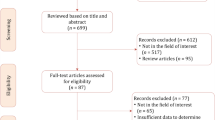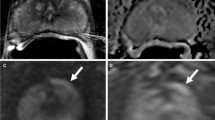Abstract
Purpose of Review
The widely acknowledged limitations of the standard prostate cancer (PCa) diagnostic paradigm have provided an impetus to explore novel imaging modalities to diagnose, localize, and risk stratify PCa. As the body of literature focused on HistoScanning™(HS) grows, there is need for a comprehensive review of the clinical efficacy of this technology.
Recent Findings
Eighteen original, English language articles were found to adequately study the use of HistoScanning™ for prostate cancer diagnosis in the clinical setting. The articles were found by conducting a bibliographic search of PubMed in April 2017 in addition to utilizing references. The studies are divided into four groups based on study design. Study methods and quantitative data are summarized for each of the relevant articles. The results are synthesized to evaluate the utility of HistoScanning™ for the purpose of diagnosing PCa.
Summary
Despite the promise of early pilot studies, there is a lack of consistent results across a number of further investigations of HistoScanning™. This becomes increasingly evident as study size increases. As various other modern diagnostic modalities continue to develop, the future of HistoScanning™, both alone and in conjunction with these technologies, remains unclear.
Similar content being viewed by others
References
Papers of Particular Interest, Published Recently, Have Been Highlighted as: • of Importance
Bjurlin MA, Wysock JS, Taneja SS. Optimization of prostate biopsy: review of technique and complications. Urol Clin North Am. 2014;41(2):299–313.
Hodge KK, et al. Random systematic versus directed ultrasound guided transrectal core biopsies of the prostate. J Urol. 1989;142(1):71–4. discussion 74-5
Ukimura O, et al. Contemporary role of systematic prostate biopsies: indications, techniques, and implications for patient care. Eur Urol. 2013;63(2):214–30.
Scattoni V, et al. Extended and saturation prostatic biopsy in the diagnosis and characterisation of prostate cancer: a critical analysis of the literature. Eur Urol. 2007;52(5):1309–22.
Schroder FH, et al. Screening and prostate cancer mortality: results of the European randomised study of screening for prostate cancer (ERSPC) at 13 years of follow-up. Lancet. 2014;384(9959):2027–35.
Dickinson L, et al. Magnetic resonance imaging for the detection, localisation, and characterisation of prostate cancer: recommendations from a European consensus meeting. Eur Urol. 2011;59(4):477–94.
Bjurlin MA, et al. Optimization of prostate biopsy: the role of magnetic resonance imaging targeted biopsy in detection, localization and risk assessment. J Urol. 2014;192(3):648–58.
Bjurlin MA, et al. Multiparametric MRI and targeted prostate biopsy: improvements in cancer detection, localization, and risk assessment. Cent European J Urol. 2016;69(1):9–18.
Ahmed HU, et al. Diagnostic accuracy of multi-parametric MRI and TRUS biopsy in prostate cancer (PROMIS): a paired validating confirmatory study. Lancet. 2017;389(10071):815–22.
Greer MD, et al. Accuracy and agreement of PIRADSv2 for prostate cancer mpMRI: a multireader study. J Magn Reson Imaging. 2017;45(2):579–85.
Pummer K, et al. Innovations in diagnostic imaging of localized prostate cancer. World J Urol. 2014;32(4):881–90.
Pavlovich CP, et al. High-resolution transrectal ultrasound: pilot study of a novel technique for imaging clinically localized prostate cancer. Urol Oncol. 2014;32(1):34 e27–32.
Moore CM, et al. Standards of reporting for MRI-targeted biopsy studies (START) of the prostate: recommendations from an international working group. Eur Urol. 2013;64(4):544–52.
Hamann M, Junemann K. How to make TRUS better: HistoScanning-guided biopsies for identification of cancer within the prostate. , in focal therapy of prostate cancer: an emerging strategy for minimally invasive, staged treatment. 2015, Springer International Publishing;: Switzerland. p. 51–58.
De Coninck V, Braeckman J, Michielsen D. Prostate HistoScanning: a screening tool for prostate cancer? Int J Urol. 2013;20(12):1184–90.
Braeckman J, et al. Computer-aided ultrasonography (HistoScanning): a novel technology for locating and characterizing prostate cancer. BJU Int. 2008;101(3):293–8.
Schiffmann J, et al. Controversial evidence for the use of HistoScanning in the detection of prostate cancer. World J Urol. 2015;33(12):1993–9.
Aigner F, Frauscher F. RE: computer-aided ultrasonography (HistoScanning): a novel technology for locating and characterizing prostate cancer. BJU Int. 2009;103(1):115. author reply 115-6
Epstein JI, et al. Pathologic and clinical findings to predict tumor extent of nonpalpable (stage T1c) prostate cancer. JAMA. 1994;271(5):368–74.
Stamey TA, et al. Localized prostate cancer. Relationship of tumor volume to clinical significance for treatment of prostate cancer. Cancer. 1993;71(3 Suppl):933–8.
• Braeckman J, et al. The accuracy of transrectal ultrasonography supplemented with computer-aided ultrasonography for detecting small prostate cancers. BJU Int. 2008;102(11):1560–5. Initial validation study reporting a sensititivity of 100% for tumors with volume ≥ 0.5 mL. The authors reported a PPV and a NPV of 80% and 100% for tumors ≥ 0.5 mL on these initial study patients and also reported strong correlation between HS tumor volume and RP histologic tumor volume (HTV) (r = 0.99, p < 0.001)
Simmons LA, et al. Detection, localisation and characterisation of prostate cancer by prostate HistoScanning(). BJU Int. 2012;110(1):28–35.
Javed S. Does prostate HistoScanning accurately identify prostate cancer, measure tumor volume and asess pathological stage prior to radical prostatectomy? Journal of Clinical Urology. 2013;6(6):395–402.
• Porres D, et al. Sextant-specific analysis of detection and tumor volume by HistoScanning. Urol Int. 2016;96(2):194–201. Largest study evaluating HS to detect PCa at RP. This study reported poor correlation between HS tumor volume and HTV (correlation coefficient of 0.064—poor agreement). The sensitivity and specificity for either threshold ranged widely and did not agree with the initial study results
Macek P, et al. Prostate histoscanning in clinically localized biopsy proven prostate cancer: an accuracy study. J Endourol. 2014;28(3):371–6.
Orczyk C, et al. A prospective comparative analysis of the accuracy of HistoScanning and multiparametric magnetic resonance imaging in the localization of prostate cancer among men undergoing radical prostatectomy. Urol Oncol. 2016;34(1):3 e1–8.
Javed S, et al. Does prostate HistoScanning play a role in detecting prostate cancer in routine clinical practice? Results from three independent studies. BJU Int. 2014;114(4):541–8.
Hamann MF, et al. Computer-aided transrectal ultrasound: does prostate HistoScanning improve detection performance of prostate cancer in repeat biopsies? BMC Urol. 2015;15:76.
Schiffmann J, et al. Comparison of prostate cancer volume measured by HistoScanning and final histopathological results. World J Urol. 2014;32(4):939–44.
Salomon G, et al. Accuracy of HistoScanning for the prediction of a negative surgical margin in patients undergoing radical prostatectomy. BJU Int. 2013;111(5):60–6.
Schiffmann J, et al. Histoscanning has low sensitivity and specificity for seminal vesicle invasion. Urology. 2014;84(5):1168–71.
Schlomm T, et al. Neurovascular structure-adjacent frozen-section examination (NeuroSAFE) increases nerve-sparing frequency and reduces positive surgical margins in open and robot-assisted laparoscopic radical prostatectomy: experience after 11,069 consecutive patients. Eur Urol. 2012;62(2):333–40.
Schiffmann J, et al. True targeting-derived prostate biopsy: HistoScanning remained inadequate despite advanced technical efforts. World J Urol. 2016;34(4):495–500.
Nunez-Mora C, et al. Utility of Histoscanning prior to prostate biopsy for the diagnosis of prostate adenocarcinoma. Actas Urol Esp. 2013;37(6):342–6.
Hamann MF, et al. Computer-aided (HistoScanning) biopsies versus conventional transrectal ultrasound-guided prostate biopsies: do targeted biopsy schemes improve the cancer detection rate? Urology. 2013;81(2):370–5.
• Schiffmann J, et al. Does HistoScanning predict positive results in prostate biopsy? A retrospective analysis of 1,188 sextants of the prostate. World J Urol. 2014;32(4):925–30. Largest study evaluating HS prediction for prostate biopsy. in 198 men. Reported NPV, {PV ranging from28.8 to 33.1% and 50.6 to 79.7%, respectivelyl. Authors also reported a false positive rate for HS of 73.1% and an AUC of 0.58 for predicting cancer on biopsy
Sivaraman A, et al. Prostate histoscanning true targeting guided prostate biopsy: initial clinical experience. World J Urol. 2015;33(10):1475–9.
Weaver RP, Noble MJ, Weigel JW. Correlation of ultrasound guided and digitally directed transrectal biopsies of palpable prostatic abnormalities. J Urol. 1991;145(3):516–8.
Heijmink SW, et al. A comparison of the diagnostic performance of systematic versus ultrasound-guided biopsies of prostate cancer. Eur Radiol. 2006;16(4):927–38.
Onur R, et al. Contemporary impact of transrectal ultrasound lesions for prostate cancer detection. J Urol. 2004;172(2):512–4.
Dahnert WF, et al. Prostatic evaluation by transrectal sonography with histopathologic correlation: the echopenic appearance of early carcinoma. Radiology. 1986;158(1):97–102.
Mitterberger MJ, et al. Comparative efficiency of contrast-enhanced colour Doppler ultrasound targeted versus systematic biopsy for prostate cancer detection. Eur Radiol. 2010;20(12):2791–6.
Taverna G, et al. Colour Doppler and microbubble contrast agent ultrasonography do not improve cancer detection rate in transrectal systematic prostate biopsy sampling. BJU Int. 2011;108(11):1723–7.
Xie SW, et al. Contrast-enhanced ultrasonography with contrast-tuned imaging technology for the detection of prostate cancer: comparison with conventional ultrasonography. BJU Int. 2012;109(11):1620–6.
Brock M, et al. Comparison of real-time elastography with grey-scale ultrasonography for detection of organ-confined prostate cancer and extra capsular extension: a prospective analysis using whole mount sections after radical prostatectomy. BJU Int. 2011;108(8 Pt 2):E217–22.
Lee F, et al. Prostate cancer: transrectal ultrasound and pathology comparison. A preliminary study of outer gland (peripheral and central zones) and inner gland (transition zone) cancer. Cancer. 1991;67(4 Suppl):1132–42.
Merrick GS, et al. Prostate cancer distribution in patients diagnosed by transperineal template-guided saturation biopsy. Eur Urol. 2007;52(3):715–23.
Bott SR, et al. Extensive transperineal template biopsies of prostate: modified technique and results. Urology. 2006;68(5):1037–41.
Lemaitre G, et al. Computer-aided detection and diagnosis for prostate cancer based on mono and multi-parametric MRI: a review. Comput Biol Med. 2015;60:8–31.
Simmons LA, et al. The PICTURE study—prostate imaging (multi-parametric MRI and prostate HistoScanning) compared to transperineal ultrasound guided biopsy for significant prostate cancer risk evaluation. Contemp Clin Trials. 2014;37(1):69–83.
Author information
Authors and Affiliations
Corresponding author
Ethics declarations
Conflict of Interest
James S. Wysock reports consultant fees from Tolmar Pharmaceuticals, Inc.
Alex Xu and Samir S. Taneja each declare no potential conflicts of interest.
Clement Orczyk reports a grant from the European Association of Urology and a sub investigator for TROD medical.
Human and Animal Rights and Informed Consent
This article does not contain any studies with human or animal subjects performed by any of the authors.
Additional information
This article is part of the Topical Collection on New Imaging Techniques
Rights and permissions
About this article
Cite this article
Wysock, J.S., Xu, A., Orczyk, C. et al. HistoScanningTM to Detect and Characterize Prostate Cancer—a Review of Existing Literature. Curr Urol Rep 18, 97 (2017). https://doi.org/10.1007/s11934-017-0747-y
Published:
DOI: https://doi.org/10.1007/s11934-017-0747-y




